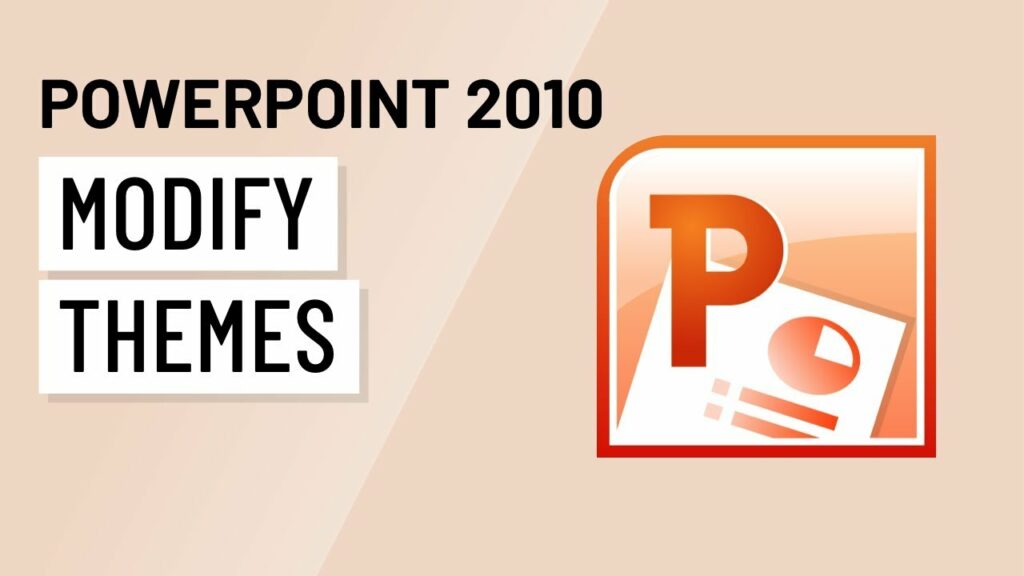Mastering Theme Modification in PowerPoint 2010: A Comprehensive Guide

Introduction:
Themes play a pivotal role in defining the visual style and consistency of presentations in Microsoft PowerPoint 2010. A well-chosen and customized theme can elevate the overall aesthetic appeal and professionalism of slides, enhancing audience engagement and message clarity. In this extensive guide, we will delve into the intricacies of modifying themes in PowerPoint 2010, exploring various customization options, techniques, and best practices for creating visually stunning and cohesive presentations.
Section 1: Understanding Themes in PowerPoint 2010
1.1 Introduction to Themes: Themes in PowerPoint 2010 are pre-designed sets of colors, fonts, and effects that provide a consistent visual identity for presentations. Themes allow users to apply a unified design scheme to all slides, creating a polished and professional look.
1.2 Key Components of Themes: PowerPoint 2010 themes consist of several key components, including:
- Color Schemes: Sets of complementary colors used for text, backgrounds, and accents.
- Font Sets: Predefined font combinations for titles, headings, and body text.
- Effects: Stylistic effects such as shadows, reflections, and gradients applied to shapes and text.
1.3 Importance of Consistency: Consistency is crucial when using themes in PowerPoint 2010. Maintaining a consistent design aesthetic across slides reinforces brand identity, enhances visual appeal, and improves audience comprehension.
Section 2: Modifying Theme Colors
2.1 Customizing Color Schemes: PowerPoint 2010 allows users to customize theme colors by selecting from predefined color schemes or creating custom color combinations. Users can adjust individual color elements, such as text, background, and accent colors, to match their branding or design preferences.
2.2 Creating Custom Color Schemes: To create a custom color scheme in PowerPoint 2010, follow these steps:
- Click on the Design tab in the Ribbon toolbar.
- Select Colors from the Themes group.
- Choose Create New Theme Colors from the dropdown menu.
- Customize the color scheme by selecting colors for text, background, accents, and hyperlinks.
- Save the custom color scheme for future use.
2.3 Applying Color Scheme Variants: PowerPoint 2010 offers variants of each theme color scheme, such as Dark, Medium, and Light variants, which provide different levels of contrast and brightness. Users can choose from these variants to adjust the overall look and feel of their presentations while maintaining consistency with the selected theme.
Section 3: Customizing Theme Fonts
3.1 Selecting Font Sets: PowerPoint 2010 offers a variety of font sets that users can apply to their presentations. Font sets include combinations of title fonts, heading fonts, and body text fonts, ensuring consistency and readability across slides.
3.2 Customizing Font Styles: Users can customize font styles within theme font sets by adjusting attributes such as font size, weight, and color. Customizing font styles allows users to tailor text appearance to suit specific slide content and design requirements.
3.3 Creating Custom Font Sets: To create a custom font set in PowerPoint 2010, follow these steps:
- Click on the Design tab in the Ribbon toolbar.
- Select Fonts from the Themes group.
- Choose Create New Theme Fonts from the dropdown menu.
- Specify font settings for titles, headings, and body text.
- Save the custom font set for future use.
Section 4: Applying Theme Effects
4.1 Choosing Theme Effects: PowerPoint 2010 offers a selection of theme effects, such as shadows, reflections, and glow effects, that users can apply to shapes and text. Theme effects add depth and dimension to slide elements, enhancing visual appeal and professionalism.
4.2 Customizing Effect Options: Users can customize theme effects in PowerPoint 2010 by adjusting parameters such as intensity, direction, and transparency. Customizing effect options allows users to achieve the desired visual impact while maintaining consistency with the selected theme.
4.3 Saving Custom Theme Effects: To save custom theme effects for future use, users can create a custom theme or save individual shapes or text boxes with customized effects as part of a slide master layout. Saving custom theme effects ensures consistency and efficiency when creating new presentations.
Section 5: Best Practices for Theme Modification
5.1 Maintain Brand Consistency: When modifying themes in PowerPoint 2010, prioritize brand consistency by aligning theme colors, fonts, and effects with the organization’s branding guidelines. Consistent branding reinforces brand identity and professionalism in presentations.
5.2 Consider Audience Preferences: Take into account audience preferences and visual preferences when selecting and customizing themes. Consider factors such as readability, contrast, and accessibility to ensure that the chosen theme enhances audience engagement and comprehension.
5.3 Test for Compatibility: Before finalizing theme modifications, test the compatibility of themes across different devices and platforms to ensure consistent appearance and functionality. Test themes on various screen resolutions, devices, and operating systems to identify and address any compatibility issues.
5.4 Iterate and Refine: Theme modification is an iterative process that may require multiple rounds of refinement and adjustment. Solicit feedback from colleagues or stakeholders and iterate on theme modifications to achieve the desired visual impact and effectiveness in presentations.
Conclusion:
Modifying themes in PowerPoint 2010 offers users the flexibility to create visually stunning and cohesive presentations that effectively communicate their message to the audience. By understanding the components of themes and mastering the customization options available in PowerPoint 2010, users can elevate the visual appeal and professionalism of their presentations. Whether customizing color schemes, font sets, or effects, careful consideration of design principles and best practices ensures that theme modifications enhance audience engagement and comprehension. With practice, experimentation, and attention to detail, users can leverage the power of theme modification to create impactful and memorable presentations that leave a lasting impression.




